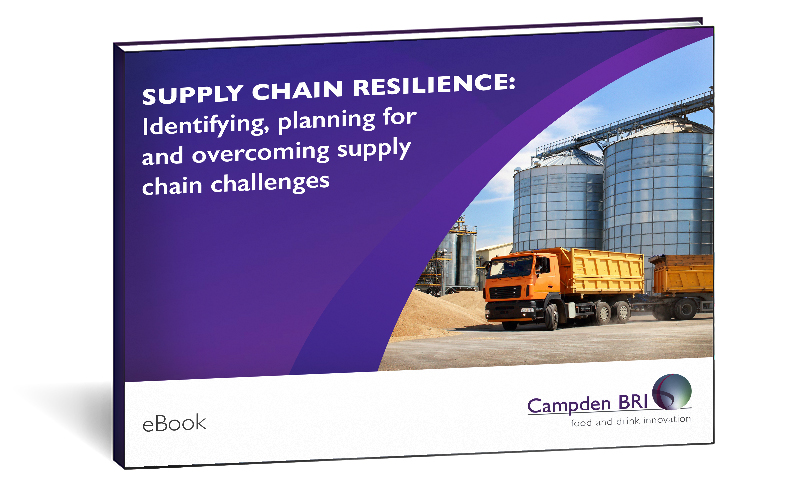Food safety plans
6 minutes
In this whiteboard presentation, Andrew Collins, food safety management systems manager, talks about food safety plans. He gives an overview of the history of food safety management and food standards, the legal frameworks for food safety and the importance of looking at food safety holistically.
Download our FREE Supply Chain Resilience eBook today! Thrive in a changing environment by being prepared, agile and resilient.


About Andrew Collins
Andrew joined Campden BRI at the beginning of 2009. With over 30-years’ experience in a wide range of food businesses (including catering), his current role focuses on consultancy work with the holistic and practical application of food safety management including the role of HACCP and good hygiene practices.
He is a certified BowTie practitioner, and is one of the few food safety experts globally using BowTie methodology – a barrier, risk-based thinking approach to risk management in the food businesses. This approach enables businesses to build holistic, resilient and adaptive systems in a rapidly changing environment.
Andrew also works on supply chain management, agriculture and water use, animal feed and traceability. Plus, he’s part of the team that manages hygiene and allergen management.
Transcript
Hello, I'm here to talk to you about food safety plans. As we all know, when we look at the history, in terms of food safety management, we started off in the 60s when NASA developed a food safety approach based upon failure mode and effect analysis to ensure that the food was safe for the astronauts. They presented this in the early 70s and we started to see the US, the FDA and the US Department of Agriculture getting involved in regulatory requirements regarding food safety.
In the 80s, we at Campden, had our first guideline written in 1987 and we started to see the involvement of catering within this approach through assured safe catering. In the 90s, and this is perhaps where we started to begin to see the fact that it was becoming much more of increasing importance, we have Codex, the organisation that makes recommendations to regulatory authorities, adopting HACCP as an approach. We had retailer standards, we had also BRC that were beginning to put the emphases back onto the manufacturer to ensure that they're producing safe food. We had in the early 90s the directive which said that we actually had to think about hazards associated with products and processes, but we didn't have to validate it or even to write it down. Then in the late 90s we had this term from the US, these pre-requisites, the site-wide environmental and operating conditions.
If we move a little bit further forward when we come into the 2000s, at the turn of the century, we had the EU regulatory requirements 852:2004, 853 and also the general food requirements. We also had the introduction of an ISO standard on food safety management systems, specifically designed to cover all areas of the supply chain, not only the manufacturing sites but also the supply chain.
Into the current decade we've had a much more importance placed upon, and additional burdens placed upon, manufacturing. We've got things like food safety culture that has been introduced, we've got words like TACCP and VACCP, which I'm sure you're all familiar with. We have the advent of the Food Safety Modernization Act in the US, the impact that that is also having, and the rise of the GFSI benchmark standards the BRC, the GFSSC 22000 and IFS, the International Features Standards.
When we look at this timeline and put it into relationships of what we have covered, we've obviously got HACCP which looked at both significant food safety hazards, but it was all about accidental contamination. Then we talked about prerequisites and we have talked for a number of years about the requirements of having prerequisites, these fundamental building blocks. When we look at the US regulatory requirements, they focus particularly upon allergens and hygiene or sanitation as well as supply chain to ensure that the process and the products are safe and the process controls that they manage perhaps through a traditional HACCP system. When we come to things like food fraud it’s all about economic motivation and we've used the term VACCP and we also then have, in terms of the food defence, the intentional. We talked about the threat assessments. These have actually worked their way into the commercial standards as well.
Underpinning all of this we have a legal framework which puts an obligation upon us to ensure that the product is safe, is the right quality and is actually authentic. When we actually take all of these together, because for us to ensure that we are able to comply, these put extra resources and burdens upon businesses to meet these requirements. When we try and think about where are we going with food safety is it just looking at HACCP, is it looking at food fraud, is it looking at prerequisites, is it looking at defence? In reality we are thinking of very much more of a holistic view which covers not only the legal framework that ensures that the product is safe and that we will then have and are able to protect our brand. We're able to protect the operation and we're also able to protect the quality.
This has been very much a top-level overview about what food safety plans are all about and perhaps where food safety management is going in the future. If you would like to learn more about this or even discuss it with us in more depth, then please don't hesitate to get in contact. What we do believe is that the food safety plan is going to be the way that we will be able to go so that we can actually, not only consider the accidental contamination having effective prerequisites, but make sure that we are able to produce a product which is safe and legally compliant. Thank you very much.
How can we help you?
If you’d like to find out more about food safety plans, contact our support team to find out how we can help.
Download our FREE ‘Supply Chain Resilience’ eBook today!
Be resilient and thrive – ensure continuity of supply of safe, quality food.







